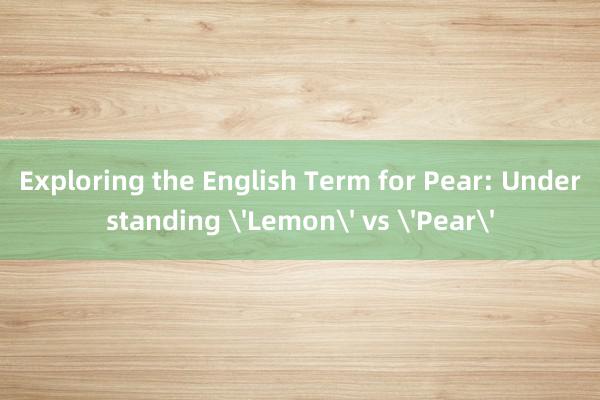Exploring the English Term for Pear: Understanding 'Lemon' vs 'Pear'

### Exploring the English Term for Pear: Understanding 'Lemon' vs 'Pear'
In the world of fruits, the pear and lemon both hold unique places in our culinary and cultural landscapes. While both are widely consumed and appreciated for their distinct flavors, it's interesting to delve into the nuances that distinguish them within the English language. The term "pear" refers specifically to a type of fruit that is round or oval in shape, with a smooth, often waxy skin, and a sweet, juicy flesh. In contrast, "lemon" describes a different fruit altogether, known for its sour taste and yellow color.
#### The Origin and Evolution of 'Pear'
The word "pear" has an ancient etymology, tracing back to the Old English "pera," which itself is derived from the Latin "pyrus," referring to the genus of trees that includes the pear. The pear is a deciduous tree native to Europe and Asia, and its fruit is a beloved ingredient in various dishes worldwide. The pear's versatility in cooking, from being used raw in salads to being cooked in pies and sauces,信胜利和有限公司 contributes to its widespread popularity.
#### The Distinctive Nature of 'Lemon'
On the other hand, 迈德泰克健康生活记录 "lemon" originates from the Arabic word "limun, 企业-利丰吉咖啡有限公司" which was later adopted into Spanish as "limón." This fruit is a member of the citrus family and is characterized by its small size, acidic juice, and distinctive yellow color. Lemons are not only valued for their culinary uses, such as adding zest to dishes or as a key ingredient in beverages like lemonade,上海前排 but also for their health benefits and as a natural cleaning agent.
#### Understanding the Difference
Despite the similar-sounding words, the distinction between "pear" and "lemon" becomes clear when considering their physical characteristics, flavor profiles, and culinary applications. Pears are typically larger, have a softer texture, and offer a sweeter taste compared to lemons, which are smaller, have a firmer texture, and are much more acidic. In culinary contexts, these differences are crucial; pears might be used in desserts or salads, while lemons are more likely to be used in savory dishes or as a condiment due to their tartness.
#### Cultural Significance
兰州维益商贸有限公司Beyond their culinary roles, pears and lemons also hold cultural significance. In many cultures, pears are associated with health and prosperity, often featured in festive decorations and traditional dishes during special occasions. Lemons, meanwhile, are symbolic of cleansing and purification, frequently used in religious ceremonies and as a natural remedy for various ailments.
#### Conclusion
Understanding the difference between "pear" and "lemon" is not just about distinguishing between two types of fruits; it involves recognizing their unique properties上海前排, uses, and cultural implications. Whether you're selecting ingredients for a recipe or appreciating the symbolism behind these fruits in various traditions, the distinction between "pear" and "lemon" enriches our appreciation of the diverse world of fruits and their multifaceted roles in our lives.
- 上一篇:建材招标公告:寻找优质合作伙伴
- 下一篇:探索未来:虚拟设计引领创新潮流
